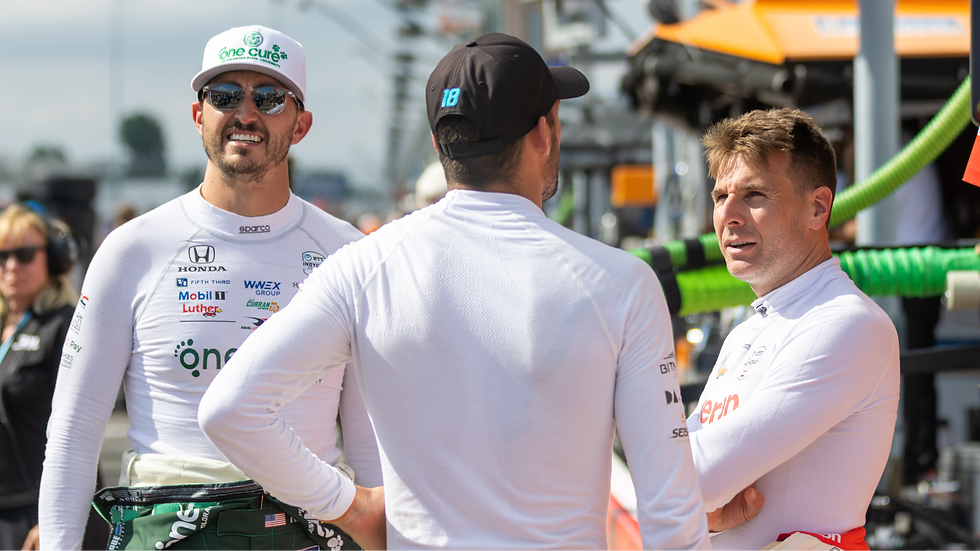The Pros and Cons of IndyCar's 2026 Schedule
- Jeffrey Hrunka
- Sep 18
- 3 min read
Jeffrey Hrunka - IndyCar Contributor

IndyCar announced its 2026 season schedule on Tuesday, featuring numerous changes. A new oval circuit, two NASCAR doubleheader weekends, and three new venues highlight the stacked schedule.
However, a change in the season finale, the removal of two iconic racetracks, and no race in Mexico City have divided fans' thoughts on the calendar. Here’s a look at the biggest takeaways from IndyCar’s schedule announcement.
Positive: More races on the West Coast
Phoenix Raceway is one of three “new” tracks added to the 2026 calendar. The track’s return continues to make the West Coast a dominant market for IndyCar, a region where its stock car counterpart has been struggling. It marks the fourth race out west, joining the Streets of Long Beach Circuit, WeatherTech Laguna Seca Raceway, and Portland International Raceway.
IndyCar and Phoenix Raceway have had an on-and-off relationship over the past several decades, as the track was a staple in USAC, CART, and IndyCar Racing Series before being removed from the schedule in 2005, for the first time since 1964. Phoenix Raceway made its return as a night race in 2016, on a three-year deal, but low attendance led to its departure after 2018.
It returns to the schedule for a second time, with the sole downside being that the track is on a one-race deal, according to FOX Sports reporter Bob Pockrass.
Negative: A race in Mexico City will have to wait
Mexico City was all but confirmed for the IndyCar schedule for 2026, until the FIFA World Cup delayed talks for at least another year. This compounds an already difficult news for the international fan base, as NASCAR pulled its race at the historic Autódromo Hermanos Rodríguez circuit, with both series eyeing a race date at the circuit for 2027.

Positive: Two IndyCar-NASCAR doubleheaders
For the first time since 2023, NASCAR and IndyCar will have not one, but two doubleheaders.
The NASCAR Truck Series joins IndyCar on the Streets of St. Petersburg for the series’ first street course race. One week later, the NASCAR Cup Series and O’Reilly Series will be at Phoenix Raceway alongside IndyCar.
This partnership is essential for the continued growth of American motorsports, as it provides an opportunity for both fan bases to tune in to one another’s racing series, compared to going head-to-head. It’s also critical for track attendance, as it encourages fans to stay at the racetrack for additional on-track action.
Negative: An absence of large ovals
The absence of Texas Motor Speedway in 2023 left fans wanting large ovals back on schedule. Outside of Indianapolis Motor Speedway, IndyCar has yet to make a splash back onto the larger ovals.
Adding the larger ovals will not only resolve this issue but also provide crucial opportunities to get into untapped markets such as Charlotte, Miami, and Chicago, which have gone without open-wheel races since 1999 and 2010, respectively.

Positive: Schedule diversity is at an all-time high
Six ovals, six road courses, and five street courses provide IndyCar with one, if not the most diverse, calendar in all of motorsports.
For the first time since 2018, there are six ovals on the schedule, with one taking place before the Indianapolis 500, not seen in two years. The schedule also marks a return to Texas, as the series travels to Arlington to race around AT&T Stadium and Globe Life Field.
From March to September, there are only two instances where IndyCar races on the same type of track on consecutive weekends. Road America and Mid-Ohio Sports Car Course are in succession, yet separated by a two-week off period, and the Milwaukee doubleheader is the sole instance of back-to-back oval races.
Negative: East Coast race fans are being left out
The topic that gets brought up every season is the lack of racing venues on the IndyCar calendar for the East Coast. The Grand Prix of St. Petersburg is the only race in this region, and it's on the west coast of Florida.
For a series that is determined to grow, they continue to miss the largest metropolitan areas in the U.S. instead, vying for racetracks in markets they already have an established presence in. The last time IndyCar had multiple races on the East Coast was back in 2019, when the series held its final race at Pocono Raceway.
There are a multitude of venues to choose from for expansion into the East Coast. It's up to IndyCar to decide if they want to expand the series’ reach.




Comments